Our interpretation of weight bearing and what is happening during that portion of the stride sequence is always up for debate. It is so complex that to gather a basic understanding of these individual features we must identify and discuss what has become the center of attention. Knowledge of physics helps to sort out some of the more complex aspects as it is a factual science. There has been research on many aspects of weight bearing but nothing that is as concrete as 2+2=4. Breakover is a good example. Lots of discussion and often without any consensus on the whole process.
Relax, we aren’t going to discuss that. Instead, it would be more proper to discuss the initial phase of weight bearing, impact, first. Unfortunately, we have to discuss the final milliseconds of the swing phase to appreciate how the leg prepares for impact.
Figure 1 (above) is just that, a picture of a left front leg ready to impact the ground. The horse is in the suspension phase and the left front leg is preparing to hit the ground by being in a “closed packed position.” That position is the leg becoming a straight line and being held in that position by tension on the tendons attaching at the coffin bone (P3), extensor at the extensor process and the deep digital flexor (DDF) on the solar surface of P3. At this point, the leg has extended to the limits of extension and will be slightly pulled backward in flight to approach the ground heel first and a more vertical approach than is inferred by this photo.
That is the primary impact definition. It has a lower amplitude of vertical forces because of the angular approach to the ground and the center of mass (CM) of the horse pushing the hoof forward while having a higher horizontal component of forces to mitigate while coming to a stop.
Farrier Takeaways
- Primary impact has a lower amplitude of vertical forces because the angular approach to the ground and the horse’s center of mass pushes the hoof forward while having a higher horizontal component of forces to mitigate while coming to a stop.
- Maximal vertical load is around midstance and is negligible at heel lift in comparison.
- A hoof angle change doesn’t alter the magnitude of force coming down the leg; it merely changes the ratio of tension to the various soft tissue units.
Once it does come to a stop, the secondary impact occurs when rapid vertical forces start to accumulate (from leg loading) to reach maximum around midstance. The hoof mitigates these forces by its inherent strengths, both anatomical and mechanical. These strengths, when combined, can withstand massive amounts of force and in three dimensions (four counting scalar ground reaction force vector) to effectively stop these forces from deforming or damaging the hoof. Within the hoof is the coffin joint, whose range of motion completely occurs with P3 remaining essentially stationary within the hoof capsule. That means that the leg articulates above the stationary P3.
Biomechanical researchers such as Jeff Thomason best describe the whole process of impact and loading like a pole vaulter running and placing their pole into the cup and vaulting over the cup (coffin joint) while it is stuck in the ground. The ground holds the cup. That is precisely the mechanism of landing by the horse with one exception, the horse carries his cup with him. That fact, for some reason, clouds the understanding of what is going on with the mechanics of weight bearing. The multiple factors of ground interaction stop the “cup” from sliding and allows the pastern to act as a pole for the body above the hoof to “vault” over the coffin joint. What an amazing apparatus the hoof is and how we attempt to understand those mechanisms.
“The hoof’s strengths are able to withstand massive amounts of force…”
Think how you would have to modify that cup if it was attached to the pole vaulter’s pole, and you had to provide a base and traction to adequately support that vaulter to accomplish that impact and function. The base would have plenty of traction and the larger the better. That thought process gives you a better appreciation for the function of the hoof, doesn’t it? Although that thought certainly doesn’t correlate to our current thoughts on shoeing (i.e. short feet and easy breakover).
From the secondary impact to heel off, the hoof remains stationary while the body and the pastern move through the coffin joint’s full range of motion (Figures 2a-2d). Vertical and horizontal forces dissipated by the hoof are transferred to shear, compression, tear and torsion and each manifest at different levels throughout the weight-bearing phase. A lot of these forces have been quantified and studied by researchers to grasp an understanding of their application and mediation even better. In a nutshell, from initial contact through midstance, the hoof is dissipating increasing vertical and decreasing horizontal force. After midstance through heel lift, it is decreasing vertical and increasing horizontal forces.
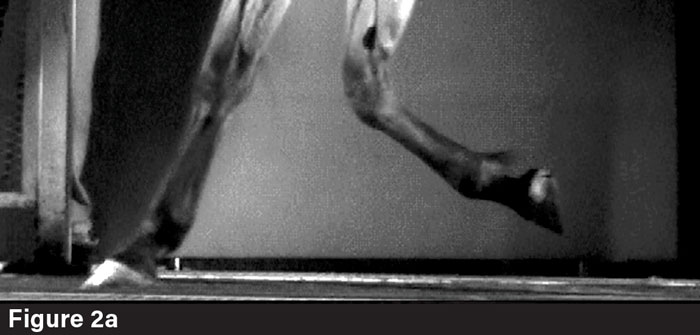
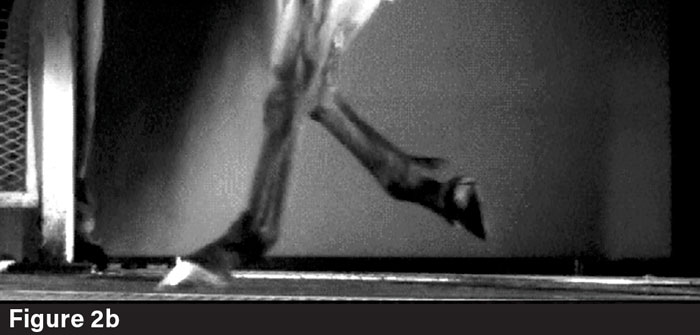
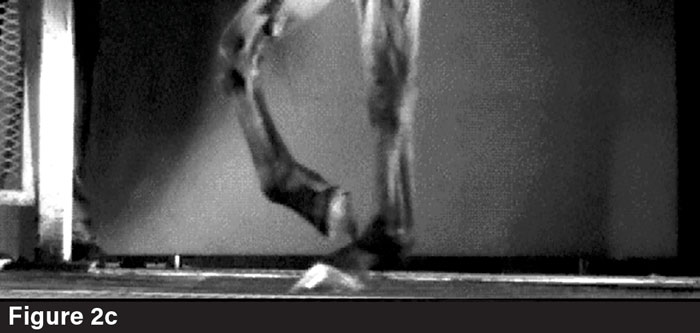
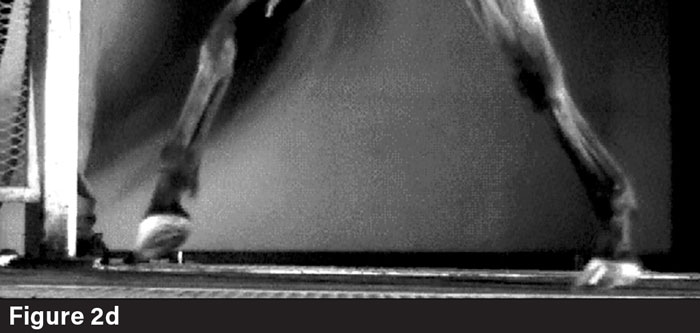
The hoof remains stationary from the secondary impact to heel off while the body and pastern move through the coffin joint’s full range of motion. Vertical and horizontal forces dissipated by the hoof are transferred to shear, compression, tear and torsion and each manifest at different levels throughout the weight-bearing phase.
If you look closely at the midstance photo, you will see the three phalanxes in a flexed arched position. That fact ensures that the superficial digital flexor (SDF) tendon and suspensory ligament (SL) are providing the lift and recoil for the fetlock. The DDF is also tensed, but not enough to overpower the SDF tendon. If it did, it would keep the arched bones arched. Kind of like pulling on a bowstring and the bow flexes from that tension. All this tension is caused by the muscles on the proximal end of these tendons. The ground simply provides an ample amount of resistance (antagonist, also known as support in some instances) for the forces generated by these muscles so that movement occurs. Of course, you cannot discount the movement over the hoof caused by the huge muscles of the shoulder and hip in their role to move the horse, that is simply not the topic of this brief paper.
The maximal vertical load is around midstance and is negligible at heel lift in comparison. Figure 3 shows the three phalanxes in an arched position (in the opposite conformation from loading), which is now applying horizontal force as the pastern in this conformation would not support vertical forces. This point would equate to the pole vaulter reaching the top of his arc and over the bar.
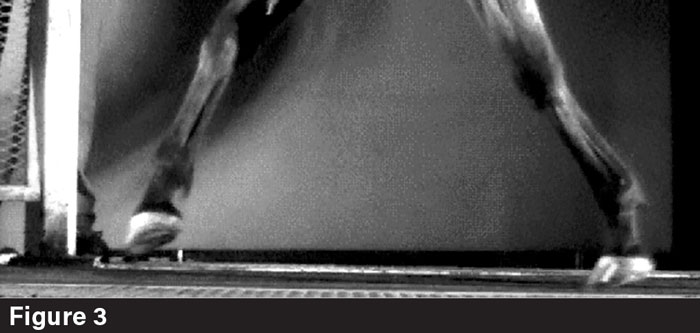
The three phalanxes are in an arched position, which is applying horizontal force as the pastern in this conformation would not support vertical forces.
Peak DDF tension occurs about halfway between midstance and heel lift when the three phalanxes become a straight line and the DDF has the advantage of two fulcrums to apply both vertical and horizontal propulsion. From the DDF peak to heel off, the tension is rapidly decreasing and has been shown with implanted strain gauges to go to zero before heel lift. (Say that again please, “the DDF goes to zero strain before heel lift.”) The pastern, hoof and heel lift is functioning like a pulley so that maximum efficiency of DDF force (a small amount at this point) transfer providing follow through of the hoof rollover and leg transfer to non-weight bearing.
Let’s acknowledge that some higher- level performance horses (Thoroughbred racehorses and pulling horses, for example) will use this position and the pulley effect of this conformation to provide additional acceleration if the shoe and toe have enough traction to do so. You must remember that the leg is essentially non-weight bearing at this point (since the carpus is open), so it is the traction that allows the horse to eke out any remaining force being applied to the ground during this follow-through phase. This propulsion might be a small amount, but in the required total amount of propulsion to maintain speed or accelerate the horse, it lowers the peak amount of force required by the main mechanics of the limb, which provides that propulsion. In other words, if you take that portion of propulsion away from the horse and attempt to maintain the same speed, the leg will become more challenged. Ring a bell? Removing the high-level performance horse’s ability to utilize that portion of weight bearing makes the leg less efficient.
If you look again at the conformation of the pastern at midstance, those arched bones are a result of the weight of the horse and movement. The soft tissue muscle-tendon unit of the superficial tendon is pulling at that unit’s attachment on that arch at the pastern joint. This conformation provides tension to straighten that arch (acting as an antagonist) to provide lift to the limb at the fetlock. The deep digital flexor is pulling at its attachment and the fetlock trying to flex or maintain the arch posture. Movement occurs from the two muscle-tendon units having a tug of war. Typical of movement mechanics you have an applied force and an antagonist to achieve fluid and stable movement.
LEARN MORE …
Gain more insight from Hall of Fame farrier Randy Luikart by reading:
This basic weight-bearing understanding is essential to fully appreciate that the length or size of the foot has little to do with the strains to the soft tissue functioning to lift and flex the fetlock. Soft tissue applied to the attachments above the hoof simply provides the means for that soft tissue to vault the limb over that coffin joint below.
For some illogical reason, we are intent to criminalize foot length and size as injurious to soft tissue that it has little to no influence on its normal function. The only major influence the hoof has is angle change. An angle change either increases the DDF tension by lowering or decreasing tension by raising. That doesn’t change the magnitude of force coming down the leg, it merely changes the ratio of tension to the various soft tissue units. If you increase DDF tension (lower hoof angle), SDF and SL tension is lowered. If you lower DDF tension (raise hoof angle), SDF and SL tension will be increased (all this change to SL and SDF tension is distributed 2:1 SL:SDF). Adding length to the hoof without making an angle change will not increase that tension ratio.
Fetlock function and strain measured around the fetlock joint is a direct result of pastern length to the center of rotation of the coffin joint, not to the end of the toe as some people assume. It must be this way as the SDF is attached to the pastern joint and is providing the lift. Since the range of motion of the coffin joint is completed while the hoof is firmly planted in the ground.
For every angle and length of pastern, there is a corresponding angle and length of hoof to allow the pastern hoof combination to function in dynamic equilibrium. Length of foot is generally directed by owners, trainers and veterinarians who apparently have cornered the knowledge of hoof length. Their collective comment is “it just looks long.”

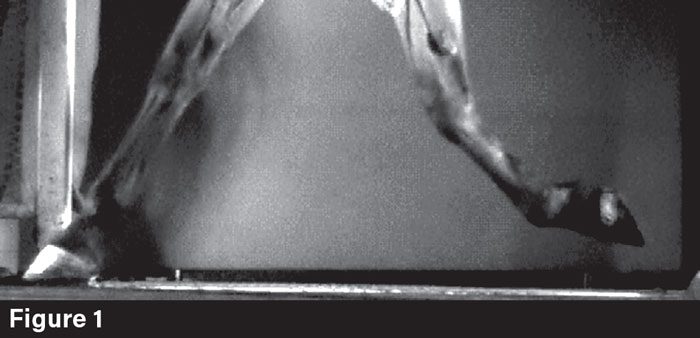
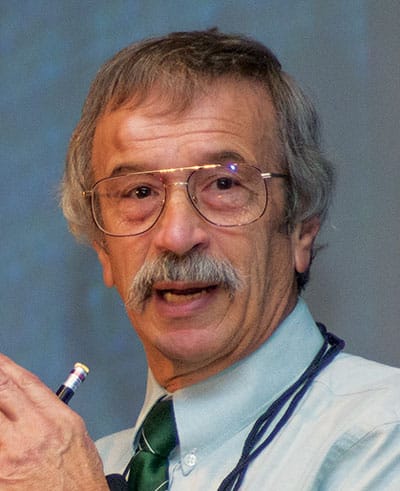






Post a comment
Report Abusive Comment